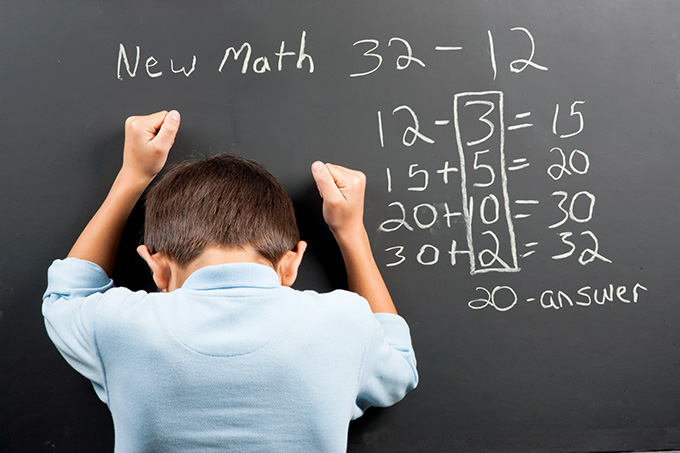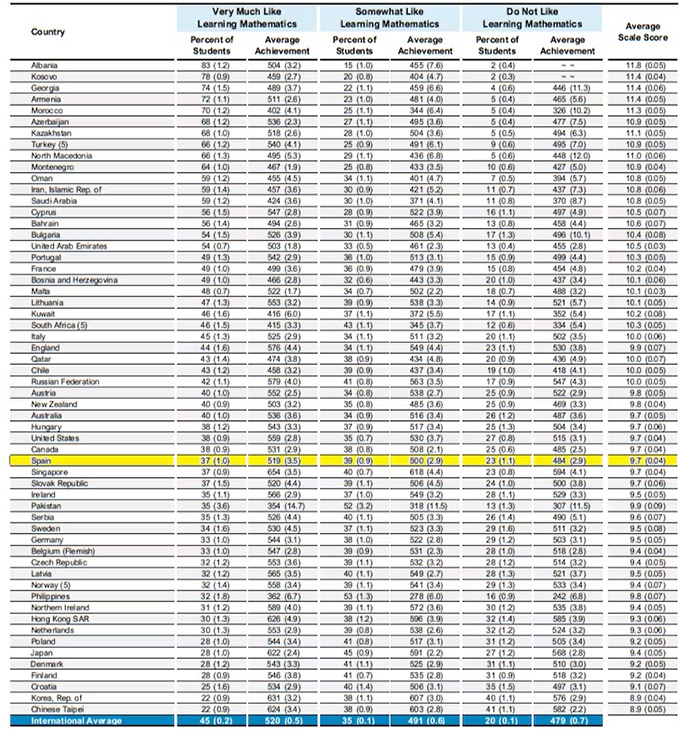
What is the first word that comes to mind if we hear “mathematics”? It is very likely that terms such as numbers, operations, calculus or algebra will appear; but if a term is usually in the imaginary of the citizenry in relation to mathematics, that is the “problem”.
This intimate connection between mathematics and problems finds its raison d’être in the very essence of mathematics education. Not surprisingly, we learn math at school to solve problems outside of it. Although this is not the only door that mathematics opens for us: it also helps us to communicate, to think critically, to create and, ultimately, to relate to the world around us. This is what the new Spanish educational law refers to when it speaks of “mathematical sense”.
Problems in teaching mathematics
This being the case, in the open debate on the curricular balance between teaching mathematics to solve problems, teaching mathematics through problem solving, and even teaching to solve problems, the balance has traditionally been unbalanced towards the first option.
This imbalance would not have had such disastrous effects if the target problems had at least been perceived by their poor solvers as their own. That is precisely a “problem”: a conflictive situation that is presented to a person (or group) in a certain environment or context, who wishes or needs to be overcome by it and for which he does not know a priori any direct resolution procedure. . Situation in which it is necessary to carry out a reflective analysis of it, the implementation of one or several strategies, decision making and the evaluation of processes and results, among other actions.
In particular, our textbooks, some of which we even cherish with some nostalgia, and our school experiences should present a rich picture of mathematical problems. But the reality remains that many of them are nothing more than simple exercises with a snobbish air and arrogance of some difficulty.
Unreal and uninteresting problems
Serve as an example this “problem” taken from a 1st ESO math book:
“A community of neighbors wants to paint one of the facades of their building. This has the shape of a rectangular trapezoid whose parallel sides measure 110m and 105m. Knowing that they have to paint 4,300m2 of wall, how long are the other two sides of the façade?”
I have a neighborhood meeting in a few minutes, and I’m tempted to take this issue to see what my community thinks.
For a problem to be and connect with reality, it is not enough to frame it in an everyday story, but the problem itself must be capable of arising in said environment, in addition to being interesting for the solver. In addition, it must move away from the procedural and require reasoning, strategic thinking, uncertainty…
In this case, nothing more than a simple handling exercise of two formulas or basic relationships and ability to “solve” the corresponding unknown in each case is required. Furthermore, the distribution of known and unknown data is meaningless if we think about what could happen in a real situation in any community.
Mathematics as a problem
And it is here where, speaking of problems, we realize that in mathematics we have a problem above the rest and that is, as the OECD points out, ultimately responsible for the PISA report :
“Too many students around the world are trapped in a vicious cycle of poor performance and demotivation that only leads to even worse results and dropout from school.”
This problem, in fact, materializes in the form of a gap between school mathematics and the personal world of students. A gap that arises at a very early age (from 8-9 years old) and that ends up leading to self-esteem problems, negative attitudes towards mathematics or mathematical anxiety, even in the teachers themselves , and divides the world into “people of letters” and “science people” , a division as unreal and artificial as it is pernicious.
Connection with reality
One of the causes that usually appear in the collective feeling of those who have broken with mathematics is the apparent lack of connection of this science with reality. Up to the point, the Spanish students in the 4th grade of primary school participating in the TIMSS 2019 study already had at that early age an index of liking or liking learning mathematics similar to (or as low as) the OECD average and the country itself. European Union, but below countries such as Portugal or Italy, to mention two realities apparently close to Spain.

List of countries according to the degree of taste for mathematics, from most to least, among students in the 4th grade of primary school. Timms Study 2019. Bos
And they are not without reason if we observe many of the mathematical problems that continue to be the protagonists of the mathematical activity in our classrooms, as well as the intention with which they are proposed.
Let’s look at an example that I have used in several didactic experiments after slightly adapting it from its original statement taken from a textbook. The problem says the following:
“My neighbor has a beautiful garden, but some field mice were ruining her flowers. She watched them for days until she was sure there were exactly 21 mice and she decided to buy a very skilled hunting cat. And so much that she was! At 7 days she had already hunted everyone down. Since she knows that I like riddles, she has asked me the following: how many mice did my cat catch each day? I already know the answer, and you? By the way, my neighbor also told me that the mice, after being caught, were released into the forest.”
(I included the last sentence because when raising it in the lower courses it was necessary to offer a happy ending by popular demand).
The original problem, with a much more sober statement in the book from which I took it, sought a simple division to conclude that the cat hunted 3 mice a day, as if the cat kept daily accounts or worked for paid goals.
The fact is that by raising the problem in years 2 (7-8 years) to 4th (9-10 years) of primary school, it was the first years that really saw this issue as a problem and offered much more realistic, creative solutions. and from informal reasoning and modeling processes. Some certainly surprising, and which also generated very interesting debates among those who offered different solutions.
Thus, part of the students pointed out that the first days they hunted a lot because they were more and, therefore, easier to catch, while the last mice took the cat several days, making, yes, the last of the 21 mice was caught on the seventh day, that is, basically offering decompositions of 21 into 7 addends, greater than or equal to 0 and with the last addend equal to or greater than 1.
At the same time, they reasoned their answer based not only on the ease of catching mice according to their number, but also taking into account non-mathematical issues such as the learning of the mice, the tiredness or fed up of the cat, etc.
The students of the highest courses, however, limited themselves to carrying out the 21/7 operation without further consideration.
Is there a simpler and clearer sign that we are losing the north of mathematics education?
Challenges and motivation
For the younger students, the mouse problem was challenging, accessible to their background knowledge, interesting in itself and motivating, that is, it was a good problem.
For his teachers, the problem offered opportunities to think, reason, argue, model in a basic way, make sense of the solution, search for strategies and, ultimately, to do mathematics.
That said, insisting that we have a problem with problems and taking advantage of the situation, who puts the bell on the cat?
Turn exercises into problems
Whoever accepts the challenge, and anticipating that there are no magic recipes or shortcuts for it, there are recommendations or tips that can help change this inertia:
- One way to connect mathematics in the classroom with solving problems in everyday life is to allow students to bring their own problems and experiences into the classroom, and show how mathematics can be a valuable tool for solving them.
- Select a priori problems that we know traditionally arouse the interest of students and whose resolution entails a rich potential for mathematical learning. A paradigmatic example of this option that has given me a lot of play in my classrooms is the one known as The case of the bad exam or bad grades , formulated by Abraham Arcadi. Is there anything that worries our students more than final grades?
- Let’s alternate, from time to time at least, from solving to posing problems: it can be as simple as providing a series of mathematical “pieces” (a function, a series of data, an operation) and asking students to invent or generate a problem that makes sense of them. This is something that open algorithms based on numbers pose at very basic levels of initiation to calculation, such as the case of ABN in Spain.
Become aware of reality
Last but not least, mathematics and mathematical problems can help us become aware of our reality, our challenges as a society and our collective commitment, which also makes them useful, as well as the desire to face the problem to solve a real social need.
A simple example that illustrates the latter is the following, which I have seen in different formats and contexts, and which I recently saw in a proposal from the Education Council of the Junta de Extremadura, after adapting, in turn, a problem for a diagnostic test. carried out in Andalusia:
“Did you know that if the world were a small town in your locality with 1,000 inhabitants, 60 people would own half the resources, 500 would go hungry, 600 would live below the poverty line and 200 would be illiterate? If this little town were ours, you would want it to change, right? Well, in fact, it is, because our planet is our little town in common. Having said that,
a) What part (fraction) of people suffer from hunger in the world?
b) What part (fraction) cannot read or write?
c) Which part (fraction) owns half of the resources?
d) What would the world be like if it were reduced to your class, your neighborhood or your family? How many would be poor, illiterate or hungry? (I added the latter)
And now, do we face the real problem, or continue as usual?
Author Bio: Jose Maria Marban Prieto is Professor of Mathematics Education at the University of Valladolid
